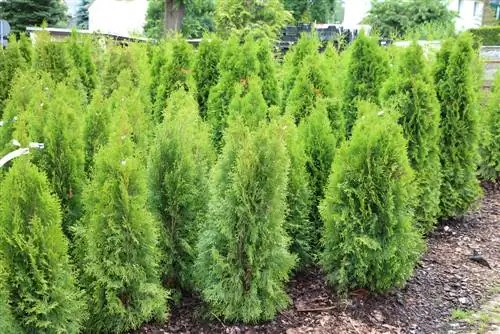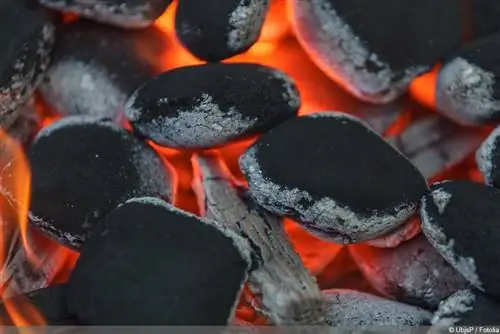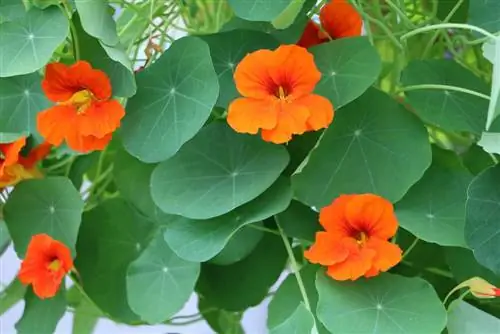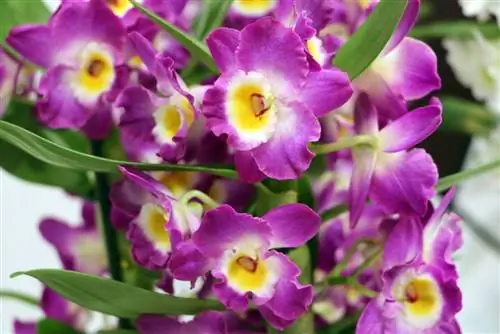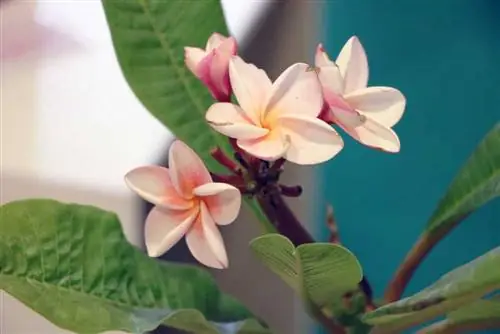- Author admin [email protected].
- Public 2023-12-17 03:39.
- Last modified 2025-01-24 12:45.
The term Epsom s alt has become firmly established among gardeners. It stands for a mineral that is technically correctly called magnesium sulfate. This name also reveals that, in addition to sulfur, the element magnesium plays a major role here. That's why it is interesting as a fertilizer if the soil lacks magnesium or plants that have a high magnesium requirement are growing in the garden. However, it is important to note that this s alt lowers the pH value of the soil. Depending on the planting, this can be beneficial or detrimental.
The s alt occurs naturally in s alt deposits. There are also numerous mining areas in Germany. However, it is now often produced synthetically. Magnesium sulfate is both odorless and colorless. It also dissolves well in water.
Which plants tolerate magnesium?
This element is essential for the formation of chlorophyll (leaf green). That's why the vast majority of plants need and tolerate magnesium. But only if it is available in the soil in the optimal concentration. While most plant species are content with rather small amounts, other plants require plenty of this mineral. These are especially conifers:
- Spruce
- Pines
- Larch trees
- Yews
- Trees of life (Thujen)
- Fir trees
- Cypresses
- and other conifers
Tip:
The older a conifer is, the more magnesium it needs. You should take this into account when fertilizing with magnesium sulfate.
Other plants
Epsom s alt is also well tolerated by rhododendrons and azaleas. This is because these plants prefer to root in acidic soil. That's why you benefit twice from this fertilizer. They absorb it to form chlorophyll and they are grateful for the lowered pH of the soil. If you also want to have a lush green lawn, you can fertilize the grass with magnesium sulfate. Research has shown that the lawn is the area of the garden most often deficient in magnesium. The pure substance does not necessarily have to be used as fertilizer. Many complete fertilizers for lawns already contain Epsom s alt.
Indications of magnesium deficiency
If a soil is deficient in magnesium, this fact cannot be determined by simply looking at the soil. Magnesium deficiency can also only occur over time. Then it is the plants themselves that give us the first unmistakable clues. Namely because their growth deviates from the expected norm:
- Plants show stunted growth
- their leaves turn yellow
- starting at the midrib, which itself remains green
- the needles and shoots of the conifers also change color
- first turn cream, then yellow and finally brown
- Leaves of some vegetables show reddish marbling
Tip:
If the yellowing only affects young leaves, the cause is not a magnesium deficiency, but rather an iron deficiency.
Causes of magnesium deficiency
Magnesium is contained in every purchased potting soil and garden soil. Even if his concentration is not always the same. There are two main reasons why it becomes scarce over time and that plants lack the building material for their leaves: Firstly, the plants themselves gradually use it up. On the other hand, rain washes some of the magnesium out of the soil. The sandier the soil, the more of this valuable mineral is lost. In loamy soils, magnesium can attach to clay minerals and thus largely “evade” leaching. Both causes require that the magnesium depot be replenished regularly.
Note:
If the clayey soil is simultaneously oversupplied with potassium and calcium, these will adhere to the clay mineral and the “unstable” magnesium will be washed out. This also leads to magnesium deficiency.
Soil analysis provides numbers
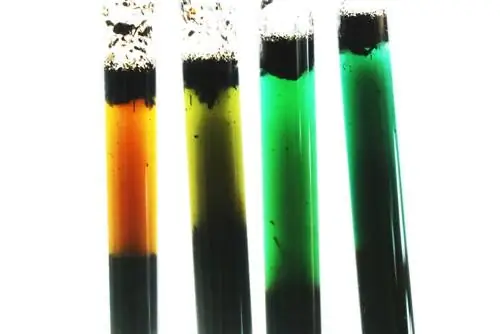
Even if yellowing leaves or needles call for Epsom s alt, magnesium deficiency does not always have to be the cause of these discolorations. And if so, we still lack information about the necessary dose. Only a soil analysis can provide clarity. What sounds so complicated and expensive actually requires little effort and costs around 20 euros. A laboratory can carry out the necessary analyzes and deliver the required values within a few days. However, beforehand, you must take several soil samples yourself according to the instructions, mix them and send a certain amount of them to the laboratory.
Tip:
Laboratories for soil analysis can be found online or inquire at the responsible environmental agency. It is sufficient if the soil analysis is repeated every 3-5 years.
Ideal magnesium levels
The value determined by the laboratory still needs to be correctly interpreted. Whether the magnesium content is sufficiently high depends on the nature of the soil. Depending on the sand or clay content, a distinction is made between light, medium and heavy soils. These are the ideal values per 100 g of soil:
- light soils: 3 to 4 mg
- medium soils: 4 to 6 mg
- heavy soils: 6 to 9 mg
If the determined value is within these ranges or even higher, there is no magnesium deficiency. This means there is no acute need for Epsom s alt.
Annual maintenance fertilization
If the magnesium content of a soil is in the optimal range, it may still make sense to fertilize with Epsom s alt at regular intervals. This will offset the annual losses. 30 g of s alt is used per m². While one application per season is sufficient for heavy soils, light and medium soils are fertilized 2-3 times with this s alt. However, if the determined value is above the optimum, fertilization should be adjusted as follows:
Light soil:
- with 3-5 mg magnesium per 100 g: halve the dosage
- with over 5 mg magnesium per 100 g: do not fertilize
Middle floor:
- with 5-10 mg magnesium per 100 g: 15-20 g per m²
- with over 10 mg magnesium per 100 g: do not fertilize
Heavy soil:
- with 9-13 mg magnesium per 100 g: 15-20 g per m²
- with over 13 mg magnesium per 100 g: do not fertilize
Tip:
Very old conifers have a high magnesium requirement. A higher dosage is necessary here. Double or triple the amounts stated above may or should be spread.
Using Epsom S alt
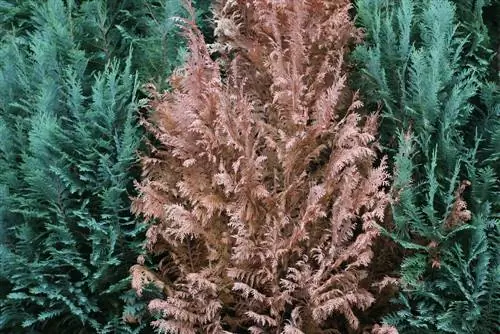
S alt is sold commercially in solid form. But it can also be easily dissolved in water. This leaves us with two options as to how we can administer this fertilizer. If it is a maintenance fertilizer, the solid s alt is simply spread underneath the plants.
- the optimal time is early spring
- alternatively or for the second fertilization in autumn
- Never put s alt directly on the roots
- water thoroughly after spreading
Resolve acute magnesium deficiency
If plants are already showing symptoms of undersupply, you should not wait until spring or fall to use Epsom s alt. You need the magnesium immediately or your condition could get worse. So that the plants can absorb the magnesium they need more quickly, it is sprayed directly onto them. Here are the individual steps of the application:
1. Before use, spray the affected plants with a water hose. This flushes debris from the leaves and allows the Epsom s alt solution to reach the plants directly. A rain shower before application saves this step.
2. Dissolve 200 g of Epsom s alt in 10 l of water. If necessary, less or more. However, the mixing ratio should always be maintained.
3. Pour the solution into a clean spray bottle.
4. Spray the Epsom s alt solution directly onto the needles and shoots of the conifer or the foliage of the plant.
Tip:
When spraying, make sure the day is not sunny. Otherwise the leaves or needles can burn.
Fertilize lawn with magnesium sulfate
Many commercially available lawn fertilizers already contain Epsom s alts. If you still want to give your lawn an extra dose of magnesium, you should keep this in mind:
- Spring is the best time
- after the first lawn cut
- sprinkle granular s alt
- then water the entire lawn
Tip:
If you follow the weather forecast, you can save yourself the hassle of watering by hand. Only spread the s alt when rain is forecast for the following period.
Buy Epsom S alt
This fertilizer is readily available and inexpensive. You can get it in hardware stores, garden centers, large supermarkets and online. Depending on the manufacturer, prices vary between 1 and 4 euros per kilogram. Since this s alt has an unlimited shelf life, it may be worth buying a large pack. However, please note the manufacturer's storage instructions printed on the packaging.
If the soil analysis also shows a lack of other soil nutrients, this s alt alone is not enough. Combined fertilizers are recommended so that each nutrient is not added to the soil separately and in a labor-intensive manner. Ask a specialist retailer for advice on which of the complete fertilizers on offer ideally meets your requirements.

